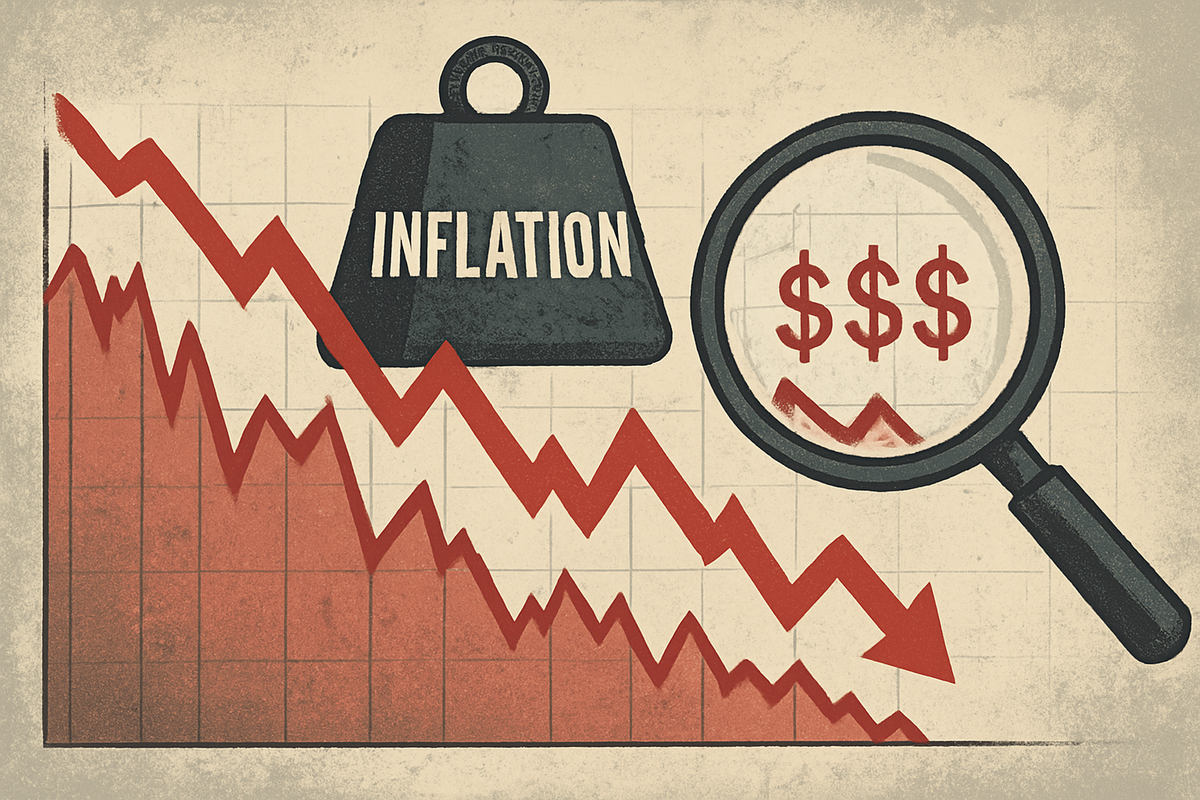
As November 2025 unfolds, global financial markets remain firmly under the sway of persistent inflation concerns, creating an environment defined by heightened investor caution, increased volatility, and a fundamental re-evaluation of investment strategies. While central banks have attempted to steer economies towards price stability, stubborn inflationary pressures, particularly in key sectors and exacerbated by geopolitical shifts, continue to cast a long shadow over market stability and immediate investment decisions.
The prevailing sentiment among investors is one of unease, reflecting a broader economic landscape where the path to disinflation is proving to be anything but smooth. This sustained pessimism, evident in plummeting economic optimism indices and a discernible shift towards risk aversion, is forcing market participants to recalibrate their portfolios, scrutinize corporate fundamentals more closely, and brace for an extended period of uncertainty. The era of easy gains, especially in speculative assets, appears to be receding, giving way to a more demanding investment climate.
The Unfolding Narrative: A Timeline of Inflationary Headwinds and Market Responses
The journey to November 2025 has been a turbulent one, marked by a seesaw battle against inflation that began to intensify in late 2024. Towards the end of 2024, inflationary pressures resurfaced, with the U.S. Consumer Price Index (CPI) showing renewed increases and core CPI remaining stagnant, signaling a halt in the disinflationary trend. The U.S. Personal Consumption Expenditures (PCE) price index also rose, contributing to market jitters. In response, the Federal Reserve initiated a series of rate cuts in late 2024, reducing the federal funds rate from 5.5% to 4.5%, a move mirrored by the Bank of England which also began gradual rate reductions. These actions, however, were met with rising Treasury yields as markets scaled back expectations for further aggressive cuts, leading to modest setbacks and increased volatility in the S&P 500.
Early 2025 offered a glimmer of hope, with a drop in U.S. core CPI in January, sparking a robust rebound in U.S. equity markets. The Federal Reserve paused its rate cuts in January and March 2025, holding steady at 4.5%, while the Bank of England continued its easing, cutting rates to 4.5% in February. This period saw the S&P 500 bounce strongly, buoyed by solid company fundamentals and resilient consumer spending. However, by mid-2025, new tariff policies implemented by the Trump administration began to introduce concerns about "stagflation" – a troubling combination of decelerating economic growth and accelerating inflation. The Organization for Economic Cooperation and Development (OECD) projected U.S. GDP growth to slow significantly, with inflation nearing 4% by year-end due driven by higher import costs. Despite these concerns, the S&P 500 regained record territory, with investors initially focusing on strong fundamentals.
As of late 2025, the picture remains complex. September 2025 saw the annual U.S. inflation rate (CPI) rise to 3.0% year-over-year, with headline inflation "inching up to 3%" in October. The Bank of England noted that UK CPI inflation peaked at 3.8% in September, still above its 2% target. In response to increasing downside risks to employment, the Federal Reserve resumed rate cuts in September and October 2025, lowering the federal funds rate to a target range of 3.75%-4.00%. The Bank of England's Monetary Policy Committee (MPC), however, kept interest rates unchanged at 4.0% in its November 6, 2025 meeting, signaling a potential December cut. Despite these persistent inflationary pressures, the Dow Jones Industrial Average achieved its 70th all-time high since November 2023, climbing to over 47,700 by early November 2025. Yet, analysts expressed concerns about "extreme valuations" and a potential "Dow Jones inflationary bubble," with a market "priced for perfection," particularly in mega-cap technology stocks fueled by the AI boom. Key players throughout this period have included central bank governors like Jerome Powell (Federal Reserve) and Andrew Bailey (Bank of England), government officials influencing fiscal and trade policies, and a diverse range of institutional investors and financial analysts constantly re-evaluating their strategies.
Navigating the Crosscurrents: Winners and Losers in an Inflationary Climate
The persistent inflationary environment, coupled with shifting monetary policies and trade dynamics from late 2024 through November 2025, has created a distinct bifurcation in market performance, with some sectors and companies proving resilient while others face significant headwinds.
Companies and sectors with strong pricing power, offering essential goods or services, or benefiting from strategic shifts are emerging as relative winners. Utilities, Energy, and Industrials are often favored, as they can typically pass on increased costs to consumers. The Financials sector, including banks and insurance companies, is also anticipated to perform well in a "higher for longer" interest rate environment, benefiting from improved lending margins. For example, AstraZeneca (LSE: AZN), the pharmaceutical giant, reported strong core earnings per share growth in Q3 2025, driven by robust sales of its essential drugs, highlighting the defensive nature of healthcare. Similarly, Expedia Group (NASDAQ: EXPE) saw its stock surge after exceeding earnings forecasts, suggesting that consumers continue to prioritize experiences, even as discretionary spending tightens elsewhere. Retailers focusing on value and private-label brands are also gaining market share as consumers actively seek deals amidst rising prices.
Conversely, businesses highly sensitive to rising input costs, shifts in consumer discretionary spending, and higher borrowing costs are facing significant challenges. The Technology sector, despite its earlier AI-driven boom, has experienced a "double whammy" from higher interest rates increasing the cost of capital and limited venture capital flows, leading to significant layoffs. Highly leveraged firms across all sectors are struggling with increased interest payments, leading to cash-flow compression and reduced capital expenditures. Companies in Discretionary Consumer Goods, such as electronics and mid-tier luxury items, are seeing reduced demand as consumers prioritize essentials. The Automobile, RV, and Boat Sales sectors are experiencing lagged negative effects from higher interest rates. Fast-food and casual dining restaurants, like Bloomin' Brands (NASDAQ: BLMN), which owns Outback Steakhouse, have reported decreased operating margins due to higher commodity, labor, and operating costs. Vehicle leasing companies like Lex Autolease and Tusker in the UK reported pre-tax losses, blaming increased depreciation, lower profits from used EV disposals, and higher borrowing costs. Even tech giants like Nvidia (NASDAQ: NVDA), Broadcom (NASDAQ: AVGO), Microsoft (NASDAQ: MSFT), Amazon (NASDAQ: AMZN), AMD (NASDAQ: AMD), Palantir (NYSE: PLTR), and Tesla (NASDAQ: TSLA) have experienced significant drops in November 2025, reflecting investor concerns over stretched valuations and the broader impact of rising costs on growth-oriented companies.
Beyond the Headlines: Wider Significance and Enduring Shifts
The persistent inflation concerns from late 2024 through November 2025 are not isolated events but are deeply intertwined with broader, transformative industry trends, creating ripple effects across global commerce and policy. One of the most significant shifts is the accelerated move towards supply chain re-shoring and near-shoring. Geopolitical tensions and the vulnerabilities exposed during the pandemic have intensified the drive for resilience over pure cost efficiency. Companies are diversifying suppliers, investing in local production, and considering bringing operations closer to home, even if it entails higher long-term costs. This trend, while costly, aims to mitigate political and logistical risks, though it also contributes to inflationary pressures by increasing manufacturing and transportation expenses.
This re-evaluation of supply chains goes hand-in-hand with a surge in automation and advanced manufacturing technologies. To offset potentially higher labor and operational costs associated with localized production and to enhance efficiency, businesses are increasing investments in robotics and AI-led process re-engineering. This aims to build more adaptable and resilient supply chains capable of withstanding future shocks. Furthermore, the traditional post-World War II model of hyper-globalization is giving way to a more fragmented landscape. Trade links are becoming more concentrated among geopolitical allies, while ties between rivals weaken, leading to a "defragmentation" and "reconfiguration" of global supply chains.
The regulatory and policy implications are equally profound. Central banks face an unprecedented balancing act, as persistent inflation demands higher interest rates, while signs of a weakening labor market push for rate cuts. The Federal Reserve's November 2025 decision to cut rates despite ongoing inflation underscores the complexity of its dual mandate (price stability and maximum employment). Trade policies, notably the tariffs implemented by the Trump administration, have become a prominent tool to protect domestic industries, but they simultaneously fuel inflation by increasing the cost of imported goods, creating a significant drag on GDP growth. Fiscal measures, including potential tax cuts and deficit spending, further complicate central bank efforts by potentially exacerbating inflationary pressures.
Historically, comparisons are often drawn to the 1970s and early 1980s, an era of high inflation and "stagflation." That period saw aggressive monetary tightening by the Federal Reserve, which triggered recessions and significant stock market declines. While direct comparisons are nuanced, the current environment shares similarities in supply chain disruptions and high consumer demand, akin to the post-World War II inflation. These historical precedents suggest that sustained high inflation is generally correlated with lower stock prices and increased volatility, often favoring value stocks and blue-chip companies with less debt over growth stocks.
What Comes Next: Navigating a Path of Uncertainty and Adaptation
Looking ahead, the stock market and broader economy face a landscape of continued uncertainty, demanding strategic pivots from both businesses and investors. In the short term, global real GDP growth is projected to remain slow, with the U.S. experiencing moderating growth into 2026. Inflation, while showing signs of moderation in some areas, is expected to remain above central bank targets for an extended period, partly due to sticky services inflation, energy costs, and the impact of new tariffs. Central banks are likely to continue their cautious approach to monetary easing, with the timing and extent of further interest rate cuts highly dependent on incoming economic data, particularly employment figures. The risk of recession remains elevated, with many economists placing the probability at one-in-three between November 2025 and the end of 2026.
For businesses, strategic adaptation is paramount. This includes a critical reassessment of pricing strategies to protect profit margins, diversification of suppliers to mitigate rising input costs, and increased investment in efficiency and automation to absorb labor and operational expenses. Strengthening cash flow management and exploring new revenue streams through innovation will be crucial for resilience. Investors must also adapt by broadening portfolio diversification beyond traditional assets, focusing on resilience and income generation, and critically evaluating stretched valuations, especially in high-growth sectors. Close monitoring of monetary policy, inflation reports, and employment data will be essential for anticipating market shifts.
Emerging Markets (EMs) face a mixed bag of challenges and opportunities. Increased U.S. trade protectionism and China's economic slowdown pose significant downside risks, while limited fiscal space constrains policy responses. However, EMs are projected to maintain a growth premium over advanced economies, driven by resilient domestic demand and supply chain diversification efforts. Countries like India are expected to lead EM growth, and nearshoring opportunities, particularly for Mexico, present significant potential.
Several potential scenarios could unfold in the coming months and years:
- "Persistent Inflation, Slow Growth" (Stagflationary Pressures): Inflation remains stubbornly high while economic growth is subdued. Central banks face a difficult dilemma, potentially needing to maintain higher rates for longer, risking deeper economic slowdowns.
- "Controlled Disinflation with Moderate Growth" (Soft Landing Attempt): Central banks successfully guide inflation down towards targets without triggering a significant recession. This optimistic scenario would see moderate stock market gains and a gradual decline in bond yields.
- "Recessionary Downturn with Disinflation": Aggressive monetary tightening or external shocks lead to a significant economic contraction. Stock markets would experience major corrections, and investors would flock to safe-haven assets.
- "Heightened Geopolitical and Trade Fragmentation": Escalating global tensions lead to further trade protectionism and disrupted supply chains, resulting in higher inflation and negatively impacting economic growth.
A Prudent Path Forward: Key Takeaways and Investor Vigilance
In summary, November 2025 finds the stock market grappling with the enduring grip of inflation, which continues to drive a palpable sense of unease and a shift towards risk aversion among investors. The uneven nature of inflation, coupled with cautious central bank policies and the unpredictable impact of geopolitical events and trade policies, defines the current economic landscape. Key takeaways include the persistence of above-average inflation, the delicate balancing act faced by central banks, and the deteriorating investor confidence leading to increased market volatility and a tech-led sell-off.
Moving forward, the market is likely to experience continued sideways trading, with tactical sector rotations as investors seek value and resilience. The critical assessment of corporate earnings and valuations, particularly in the high-growth technology sector, will remain paramount. The significance of this period lies in its potential to usher in a prolonged era of higher inflation, challenging central bank credibility and demanding fundamental shifts in corporate strategies and investment approaches.
Investors should remain highly vigilant in the coming months and years. Crucial indicators to watch include upcoming U.S. CPI reports (with the November 13, 2025 report being a major catalyst), the Federal Reserve's decisions at its December meeting and its guidance for 2026, and the release of official employment data once the U.S. government shutdown concludes. Geopolitical developments, global energy prices, and the impact of fiscal policies, such as the UK's Autumn Budget, will also continue to shape market dynamics. Given the prevailing uncertainties, a diversified investment approach, a focus on companies with strong fundamentals and pricing power, and maintaining a portion of one's portfolio in cash to capitalize on potential market dislocations are prudent strategies.
This content is intended for informational purposes only and is not financial advice.






